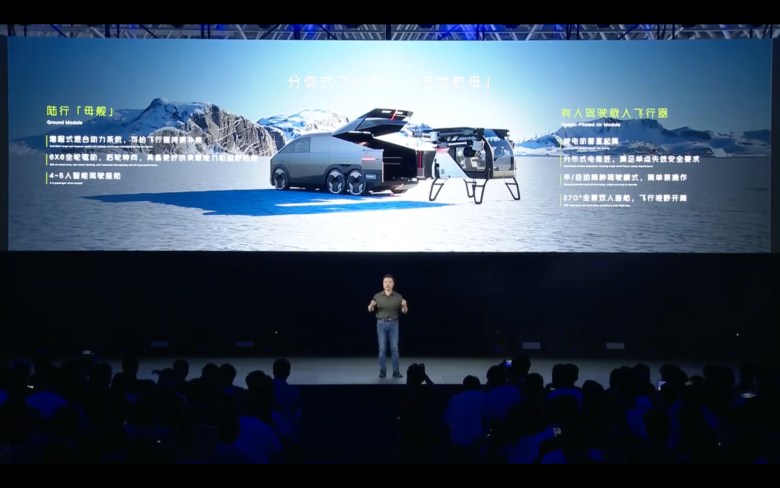Xpeng Motors teased how it sees the future of electric vehicles on Tuesday with the debut of its first multi-purpose vehicle model and a new timeline for the expansion of its self-driving software, as it faces an unprecedented offensive from major rivals like Huawei in a hotly competitive battleground.
Chief executive He Xiaopeng also revealed that the company has made significant progress in bringing flying cars closer to reality, while showcasing a working prototype of its humanoid robot, in a move reminiscent of Tesla’s introduction of its Optimus bot last September.
Here are the key highlights from Xpeng’s annual 1024 Tech Day event.
First MPV
Navigating within a sharp and narrow turn at low speed on the stage at Tuesday’s event, Xpeng’s X9 is claimed to be the world’s first multi-purpose vehicle model equipped with rear-wheel steering as a standard configuration. This would allow the seven-seater, three-row van to handle “just like” a regular-sized sports utility vehicle, said He (our translation).
Xpeng’s next-generation smart cabin system, the XOS, will also be available first to the owners of the X9, which is set to be formally launched at the upcoming Guangzhou Motor Show on Nov. 17. Powered by Qualcomm’s five-nanometer 8295 processor, the in-car software will offer a split screen mode, allowing drivers and passengers to run different applications simultaneously side-by-side for efficient multitasking.

Marking Xpeng’s entry into the Chinese MPV segment, the all-electric X9 will have to compete with an increasing number of similar offerings by established makers including BYD’s Denza brand, Great Wall Motor, and Dongfeng’s Voyah marque. Huawei-backed Aito and Li Auto are also set to launch their first MPVs later this year, targeting China’s growing three-generation families with larger interior car spaces.
Self-driving availability
Xpeng has also begun its switch to a more affordable hardware suite by removing some sensors from its incoming X9 model, betting more on cameras and artificial intelligence for its XNGP advanced driver assistance system, according to He.
The Chinese automaker has updated its self-driving technology with what it described as some of the most advanced occupancy networks in the industry, comprising a deep neural network that reconstructs barriers and vehicles and predicts occupancy in a three-dimensional space for collision avoidance.
A similar move has allowed Tesla to remove several ultrasonic sensors from its vehicles while enabling high-definition spatial positioning, longer range visibility, and the ability to differentiate between objects with its Full Self-Driving Beta software, which was announced by the US automaker last October.
CEO He said Xpeng will deploy its XNGP system for urban traffic roads in 50 cities by December and make the functions available to drivers across China and Europe by 2024. It is competing with Huawei, which has quickly emerged as a rising player in the industry and previously announced a nationwide roll-out of similar features by year-end, while rivals BYD and Li Auto are playing catch-up.
Flying cars and robots

Experimenting with different approaches around flying cars, Xpeng also showcased two prototype aircrafts, or electric vertical takeoff and landing vehicles (eVTOLs). One of them boasts a two-in-one design that can fold up its wings and other components into the vehicle body, although He acknowledged that there are still some safety issues to be addressed.
The 46-year-old serial entrepreneur sees greater potential for the commercial adoption of the other prototype, which is built on a modular system allowing the separation of the flight and automobile components. This model has a spacious interior with five seats while on the road and is powered by an extended-range hybrid engine, which can also recharge its aircraft component as it drives; up in the sky, the model is capable of carrying two passengers in an all-electric mode.
Xpeng further surprised the audience on Tuesday as its humanoid robotic prototype, the PX5, made its first public appearance. The company showcased the robot’s ability to navigate different terrain and pick up hand-held objects such as pens in a video. He envisions a near future where such AI machines could help look around in its factories or even mingle with customers at showrooms, hopefully by this time next year, he added.


